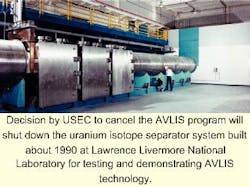Less than a year after the US government privatized its uranium-purification facilities, the new private company canceled an ambitious program that sought to use lasers to purify uranium, in favor of another laser-based technology that is thought to be simpler and less expensive to field. The board of directors of the US Enrichment Corp. (USEC; Bethesda, MD) voted June 9 to suspend development of the Atomic Vapor Laser Isotope Separation technology (AVLIS).
The decision could cost the jobs of 200 employees at Lawrence Livermore National Laboratory (Livermore CA) and 300 other employees of contractors at the laboratory, all of whom were working on the AVLIS program for USEC.
The AVLIS technology uses a finely tuned copper-vapor-laser-pumped dye laser operating with average power of more than 1 kW to separate isotopes of uranium vapor in a vacuum chamber. The laser is tuned so that when its beam hits an atom of the U-235 isotope, the atom will lose one its electrons and thus become a positively charged ion. Electrically charged plates collect the ions for further processing.
The Livermore lab has been developing the AVLIS process for 26 years, and the federal government spent $1.8 billion on it before USEC was privatized last year (see Laser Focus World, Oct. 1997, p. 78). Since then, the company has spent another $100 million on the technology, but anticipated having to spend even more before AVLIS became operational.
"Based on the results of a recent series of test runs, we have identified continuing issues that we believe would take at least another year to address satisfactorily and, once addressed, would increase construction costs [of a commercial separation facility] beyond the previous $2.5 billion estimate," J. William Bennett, vice president of advanced technology at USEC, said in a statement. "Even if these issues were resolved, the resulting economics, weighed against the market price trends for enrichment, would provide too low a rate of return on investment for the risk involved."
Citing the competitiveness of the uranium market, Elizabeth Stuckle, a spokeswoman for the company, declined to discuss the specific technical problems that the AVLIS system was encountering. "The investment of time and money that would be needed to address those issues is significant," she said. "We're not saying that the technology won't work."
Bruce Warner, AVLIS program leader at Livermore, acknowledged some difficulties with developing the separator-the part of the AVLIS system that actually separates charged atoms of different isotopes. "We didn't have a super successful year this past year," he said. "We've had a bumpy road, but all R&D has bumpy roads." But, he added, "There are no show stoppers for AVLIS. It works."
Workers at Livermore now are in the process of shutting down experimental equipment and writing up their experiments (see photo). USEC owns the intellectual property rights to the AVLIS technology, and negotiations between the company and the US Department of Energy will determine who owns the experimental equipment, said Warner. The termination of the AVLIS project essentially terminates the lab's entire work in laser isotope separation, because the AVLIS project represented "99% of our work in isotope laser separation," said Warner.
Since late 1996, USEC had been examining an alternative laser-based purification technology, called SILEX, that is being developed by Silex Systems Limited (North Ryde, New South Wales, Australia). "This decision means that SILEX, which is fundamentally a different process from AVLIS, is now the only laser-based technology being considered for future deployment by USEC," Silex Systems said in a statement.
One advantage of the SILEX system over AVLIS is that SILEX uses uranium hexafluoride, a compound that already is commonly used in the uranium industry. By contrast, AVLIS processes liquid uranium metal, which is more difficult and costly to handle. This year, Silex Systems is due to complete a pilot device featuring the SILEX technology for USEC, which would be used to test the economics of using SILEX to purify uranium. Under an agreement between the two companies, if the module passes the test, Silex Systems would be awarded a contract to design and build a pilot plant using its technology.
Although USEC had publicly acknowledged that it has been examining SILEX as an alternative to ALVLIS, the enrichment company had given no public indication that a choice between the two was imminent. Warner, for one, said he had no inkling that the decision was afoot. "I was stunned and dismayed," he said.
Investors also may have been taken by surprise. In a routine quarterly filing with the Securities and Exchange Commission about a month before the decision, the company reported spending 44% less on AVLIS in the first quarter of 1999 than the first quarter of 1998. "The reductions in the fiscal 1999 period reflect lower spending on design and licensing activities while activities have been focused primarily on integrated operation of the laser and separator systems to verify enrichment production economics," the company said in the filing.
USEC spokeswoman Stuckle maintained that the company did not surprise investors. "We have no disclosure issues here," she said. She said that the choice was made after a lengthy review of all research and development projects at the company. "The decision was not made quickly. We had been studying the situation with AVLIS for some time."
Vincent Kiernan | Washington Editor
Vincent Kiernan was Washington Editor for Laser Focus World.
